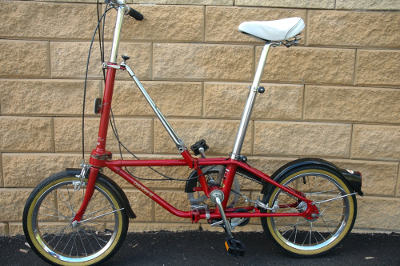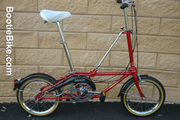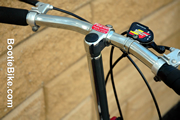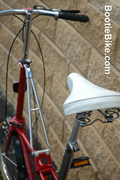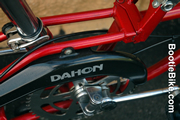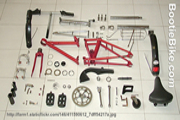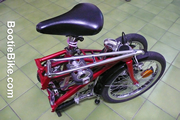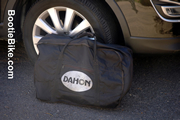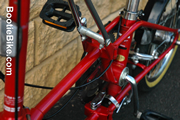1988 Dahon Classic III
The ride you can hide
This bike is an affront to good bicycle design. A clunky, rattly difficult-to-fold beast that's heavy and slow. Your kind of bike? Well, it is on BootieBike…
This, the original Dahon, brought the joys of folding bicycles to the masses. Flawed it was, but this bike had enough going for it to catapult the Dahon company from nowhere to the biggest in the folding business. It was the work of Dr David Hon, a physicist at the research labs of the Hughes Aircraft Company who, 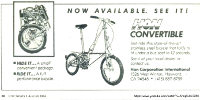 in the late 70s, turned his attention away from researching tactical lasers to the development of a portable bicycle – it was time for something more challenging, I suppose. (You can watch a mini history of Dahon here.)
in the late 70s, turned his attention away from researching tactical lasers to the development of a portable bicycle – it was time for something more challenging, I suppose. (You can watch a mini history of Dahon here.)
Hon, with the help of his brother Henry, introduced their baby to the marketplace in 1982. It was based on a short, squat steel frame, in two parts, with a clever hinge in the middle. Each end had a Raleigh RSW-esque 305-sized wheel and fat soft tyre to soak up the bumps. A distinctive diagonal strut linked the very long, folding steering stem and frame, and the seat post 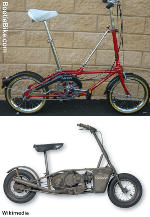 was of the multi-part, telescopic type. I think its general layout has a lot in common with that of the wartime paratrooper Welbike (later Corgi) motorcycle.
was of the multi-part, telescopic type. I think its general layout has a lot in common with that of the wartime paratrooper Welbike (later Corgi) motorcycle.
Compact and affordable, but obvious compromises
Others had produced compact folders before, but this one was usable, durable and affordable. Its shortcomings were obvious to anyone who rode it – or picked it up – but it must have filled a need as it kept the Taiwan factory busy for many years. It was advertised as the 'ride you can hide', and that it delivered; the Dahon in its bag could be hidden under a desk at work 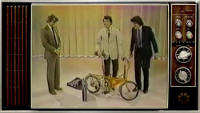 or almost any other place you wouldn't otherwise dare to put a bike.
or almost any other place you wouldn't otherwise dare to put a bike.
Meant for use, the Dahon came with practicalities like mudguards, a decent chainguard and, on the right model, a three speed Sturmey Archer hub gear. And it was mostly well finished, with quality paint and lots of chrome. (It was even made in stainless steel for a while.)
But it was very heavy, with that mass of frame tubes and steel (cheap) components. Affordability has its price, and one paid with limited potential for carrying on public transport and other situations in which lightweight portability was important. (There is the old saying: Lightness, strength and affordability: pick any two…) The Dahon weighed close to twice as much as the Bickerton, the original lightweight portable folder, but then it was much cheaper too, and it didn't suffer the shortcomings of that bike, such as a tendency to fall to bits or squeak and groan when ridden.
Dynamic capabilities were not high in the list of the Hon's design priorities, and those uninterested in a sports ride would not have been disappointed. This was not helped by a slight 'looseness' in the frame, caused by the connection between the diagonal strut and the steering stem not being fixed. The strut just clipped in, and it formed a pivot point to allow the steering stem to rotate as the handlebars turned.
Folding frolics
Folding the Dahon can be fun – would you like to try? Ok, with the hinged drive side crank at 6 o'clock,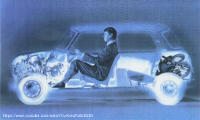 unscrew the black knob and flip the crank up to 12 o'clock, so the
unscrew the black knob and flip the crank up to 12 o'clock, so the  pedal faces inwards over the top of the frame; Undo the quick release for the telescopic seat posts and lower them; Release the catch at the top of the diagonal strut and fold the strut back; Undo the quick release for the steering post (and handlebars) and hinge it down to the side; Flick the quick release to fold the frame in half.
pedal faces inwards over the top of the frame; Undo the quick release for the telescopic seat posts and lower them; Release the catch at the top of the diagonal strut and fold the strut back; Undo the quick release for the steering post (and handlebars) and hinge it down to the side; Flick the quick release to fold the frame in half.
If you did all that in the correct sequence you will be left with a small, dense package you can lump into the carry bag. If you didn't you would likely spend the next few minutes playing bicycle origami. With practice you could very well master the art of folding the early Dahon – I did for a while. Unfolding the bike is generally easier, but still a bit fiddly, especially if the telescopic seat posts tend to stick as they do on this example. As with most folders with slide down seatposts, it pays to mark the correct height with permanent marker.
Somehow this heath robinson of a folder pushed the right buttons in the market when it was released, and for a long time after. But its success means it will never score many points as a collectible. And, it has to be said, it's not for those who highly value ease of folding, light weight or riding dynamics. In just about every way it has long been left behind by newer, more practical designs, not least later model Dahons.
Yet I think the original Dahon will maintain a lasting appeal; firstly, as a 'character' bike, a usable – yes usable – representative of a period when there weren't many practical choices for portable folders. And, just as importantly, it's a funky little thing. Who can deny that?

